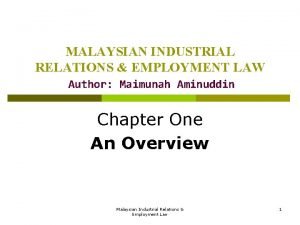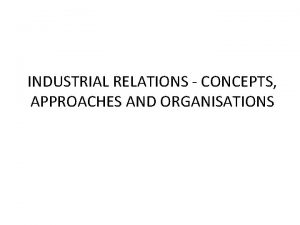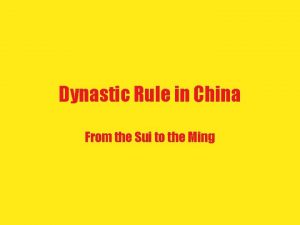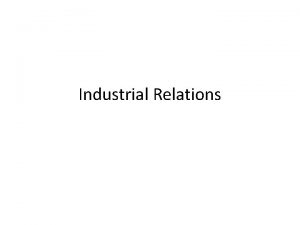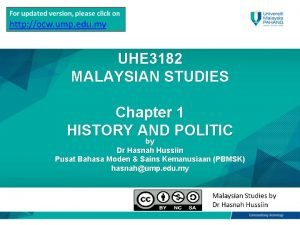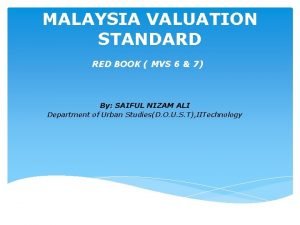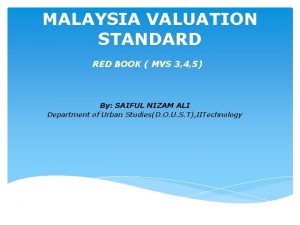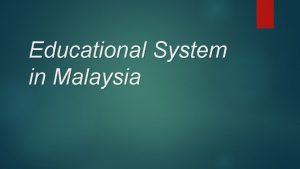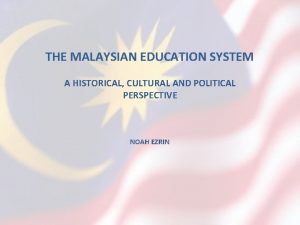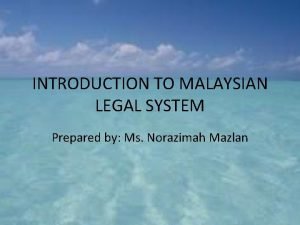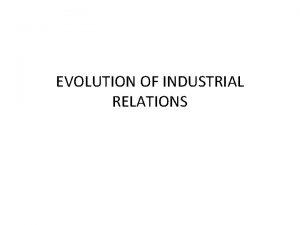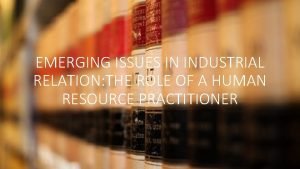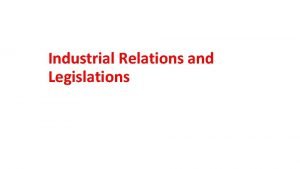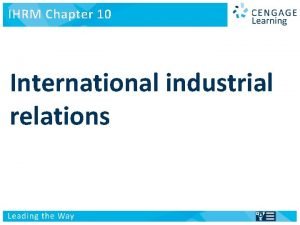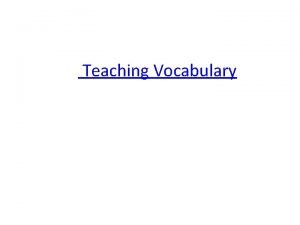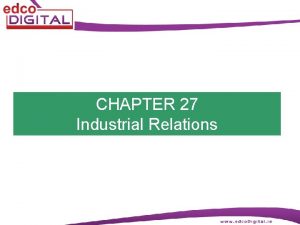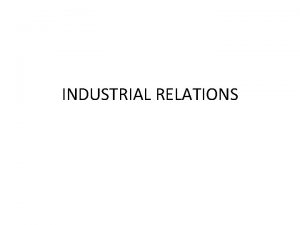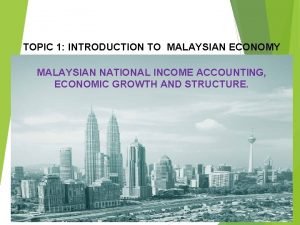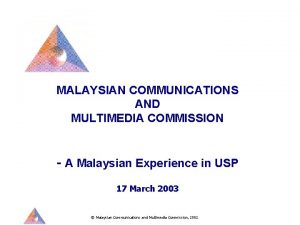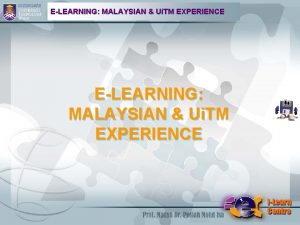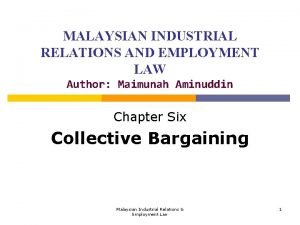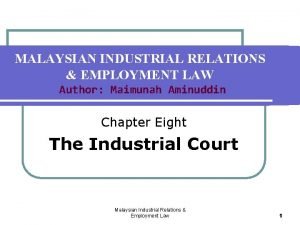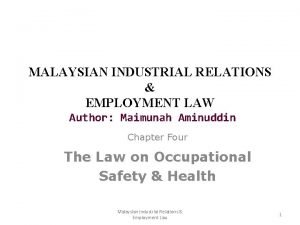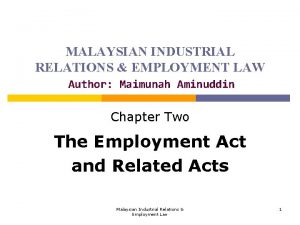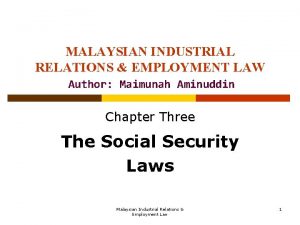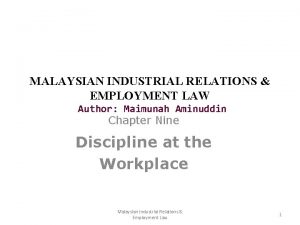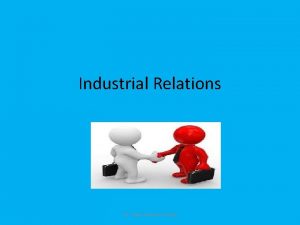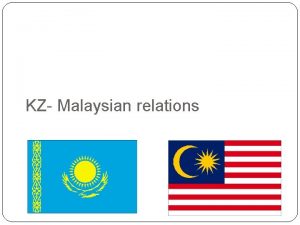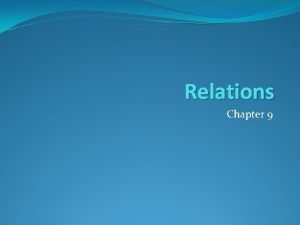MALAYSIAN INDUSTRIAL RELATIONS Definition Systems that encourage industrial



































- Slides: 35

MALAYSIAN INDUSTRIAL RELATIONS

Definition Systems that encourage industrial harmony It is for the regulation of relations between employers and workmen or employees and their trade union and the prevention and settlement of trade disputes. Focus on 3 aspects: l l l – – – Relation between employer and union Employment law Discipline procedures and terminating service contract

Importance of IR l l l One of the important aspects in human resource management To create a harmonious relation between employer and employee To ensure that employees receive fair and just treatment and avoid conflicts in organization

Industrial relations system in Malaysia l Made up of three parties/or the tripartite systems: Employer – Employees (represented by union) – Government Industrial Relations Act 1967 –use to regulate the relation between employer and employee – l

Industrial relations system in Malaysia l Code of Conduct for Industrial Harmony 1975 was introduced to maintain harmonious relation between employer and employee – – There are 47 issues covered regarding employer and union responsibilities, collective bargaining, etc Generally, IR in Malaysia is controlled by the government.

Definition of Trade Union l Section 2, under Trade Union Act- “Trade Union is any association or combination of workmen or employers. . . whose place of work is in West Malaysia, Sabah or Sarawak. . . ” l a. Within any particular establishment, trade, occupations or industries; and b. Whether temporary or permanent; and l

…continued l c. Having among its objects one or more of the following: – The regulation of relations between workmen and employers for the purposes of promoting good irs between workmen and employers, improving the working conditions or enhancing their economic and social status, or increasing productivity; – The regulation of relations between workmen and workmen, or between employers and employers; – The representation of either workmen or employers in trade dispute; – The conducting of. . or dealing with trade union disputes and matters related thereto; or – The promotion, organization or financing of strikes or lockouts in any trade or industry or the provision of pay or other benefits for its members during a strike or lockout.

Trade Union (TU) TU Functions: l – – Protecting TU members through collective strength; Economic controller – represent employees on issues such as salary and employment contract Support and help employees, such as advise and counselling, benefit Input provider to government on issues related to employees

Membership of TU According to Industrial Relations Act (Section 5); workkers in Malaysia have the right to form and join TU –FREEDOM OF ASSOCIATION In addition, The Act states that: l l – – No employer shall prevent a worker from joining a union by putting a condition in his contract of employment; No employer shall refuse to employ a worker on the grounds he is a TU member or officer; No employer shall discriminate against a worker (for example in terms of promotion) on the grounds he is a TU member or officer; and No worker shall be threatened with dismissal or dismissed if he proposes to join a TU, OR if he participates in union activities.

Joining a Union All workers over the age of 16 yrs have the right to join an appropriate union- one which represents workers in their trade, occupation or industry (Peninsular Malaysia, Sabah or Sarawak) l – – Union members under 18 yrs of age are restricted in their union activities (not entitled to vote on matters involving strike, dissolution of the union or ammendment of the rules in TU) Union members under 21 years of age are not eligible to be elected as officers of the union. Pekerja berumur kurang 16 tahun Specified group of workers are restricted from joining TU. These are members of the police force, armed forces and prison service.

Why joining TU? Dissatisfaction with management l – - Underpaid salary Dangerous work environment No job security/warranty Less concerned about employee welfare Social Needs l - Platform to get to know other people To benefited from facilities provided by union (e. g; onsite day care centre)

Why joining TU? Leadership opportunity l – – Opportunity to demonstrate leadership abilities There are organizations that incorporate union leader’s position into their formal organizational structure (usually the lower level management) Peers Influence l - Pressures from supervisor and co-workers to join TU

Types of TU in Malaysia Three types: l – Public Sector TU ° – Private Sector TU ° – Eg: National Union of the Teaching Profession; the Malayan Nurses Union; Eg: National Union of Bank Employees (NUBE) Employer Association ° ° Known as association not union Eg: The Malayan Agriculture Producer’s Association (MAPA)

Collective Bargaining(CB) Bargaining process between employer and their employees regarding terms and conditions of service/employment Union will represent employees in CB Union needs to be registered in order to get recognition from employer before representing employees in CB Four important issues usually bargained: l l – – Wage/benefit Work hours Employment terms and conditions Grievances

Collective Bargaining Prerequisites to effective CB are that the union: l – – – l Be recognised by the employer; Has adequate financial strength; and Members are united. The outcome of CB is known as collective agreement

Collective Bargaining Process Ready to bargain Develop the bargaining strategy Implement bargaining process Signing of collective agreement

Collective Bargaining Process First step: Ready to bargain l – – Union needs to collect informations and facts to support argument during CB process Example of information: employee performance record, overtime record Union needs to clearly develop objective of the CB Union needs to have knowledgeable and skillful bargaining team

Collective Bargaining Process Step 2: Develop Bargaining Strategy l – – Union needs to understand its own power and the employer as well Union needs to identify the correct and proper strategies to be used during bargaining Strategy planning should be consistent with the information collected during the first step and also to take into consideration employer’s power The final outcome of collective bargaining should be the “winwin” strategy

Collective Bargaining Process Step 3: Implement the Bargaining Process l – – – Both sided (union and employer) should be patient throughout the bargaining process Bargaining team needs to be knowledgeable about employment law and industrial relations system in Malaysia Union needs to present all the facts collected during the first step

Collective Bargaining Process Step 4: Signing Collective Agreement l – – – Involves the process of collection of recommendations to be included during signing the colective agreement Collective agreement should be in written form (Industrial Relations Act, 1967) The content of colective bargaining agreement should be stated clearly using the language that both parties can understand well

Grievance An individual worker’s complaints towards employer is termed as “grievance” Employee and its union have the right to make complaints if they are not satisfied with their employer Factors that lead to grievance: l l l – – Employer denied employee’s right to be promoted Employer does not appreciate outstanding achievement by employee Employer exaggerate small mistake done by employee Discriminate employee based on different religion, culture and race

Steps in Grievance Union receives complaints from individual employee Union proposes complaints to employee’s immediate supervisor to settle the complaints If the immediate supervisor fails to settle the complaints, union can propose the complaints to the top management in the organization

Grievance For a trade dispute to exist, the employee concerned must be represented by their union to settle the grievance Factors that enable union to represent employee in trade dispute: l l – – Employee finds no other ways to settle grievance There exist conflicting opinion between employer and union regarding terms and conditions of employment The agreement results or the concerned laws are not implemented by employer There exist conflicting opinions regarding terms in collective agreement or legal decision from Industrial Court

Grievance Factors that hinder union to represent employee in trade dispute: l – Individual worker has a complaint concerning alleged interference by an employer with his right to join or not to join a trade union ° – The worker may complain to the Director-General of Industrial Relations or refer to the industrial court Individuals who believe that they have been dismissed without just cause or excuse ° The worker may complain directly to Department of Industrial Relations

Industrial Action by Employees The only forms of employee industrial action recognised by the labour laws are: l – – Picketing Strike

Picketing l l l l The most common form of industrial action taken by employee Done to comunicate issues to the public and to embarrass the employer Prominent display of banners and placards with derogatory comments about their employer and management The Industrial Relations Act (Section 40) allows workers to attend at, or near, their workplace during trade dispute for the purpose of peacefully giving info to the public and other workers and to persuade other workers not to work if a strike has already been declared. Only workers directly involved in the dispute can participate in the picket (although an officer or employee of the union can be present to ensure that the picketing is carried out according to the law) Picketing must not intimidate anyone, and must be peaceful

Strike Occurs when a group of workers refuse to work until their employer accepts their demands Involves stopping of work by a group of employees including any attempt to limit or slow down production on purpose 2 types of strike: l l l – – Strike relating to collective bargaining Strike that has no relation to collective bargaining

Strike relating to collective bargaining l – when employer is not willing to provide collective bargaining or no resolution during collective bargaining Strike that has no relation to collective bargaining l – Due to factors such as terms and conditions of employment, retrenchment, layoffs and promotion issues

Strike Procedures: l – – – Secret ballot must be held by those eligible to strike, clearly stating the issues leading to the proposed strike The results of this ballot must be sent to the Director. General of Trade Union s by the union secretary within 14 days of taking the ballot Strike can only take place if two third of those entitled to vote agree to the action Strike can take place after waiting 7 days after the ballot results have been sent to the Director-General Secret ballot is only valid for 90 days, and if strike has not taken place within this period, a new ballot will be required if the union intends to continue with the strike action

Employer Actions l l Employer also has the right to engage in industrial action The most common industrial action taken by employer is the lock-out Employer refuses to allow the workers to work until the dispute between them is settled Alternatively, the employer can take steps to fight a strike by keeping the firm operating ; either by placing managerial or non-union employees in the strikers’ job or by hiring replacement workers

Settlement of Trade Disputes l l Direct Negotiation Conciliation Mediation Arbitration

Settlement of Trade Disputes Direct Negotiation l – – – The ideal method for settling a dispute Discussion between employer and the union until a satisfactory compromise is reached Solutions arrived at by mutual decision between the two parties without the involvement of an outsider

Settlement of Trade Dispute Conciliation l – – Arriving at a settlement of a trade dispute with the help of a third, neutral party Is carried out by officers of the Department of Industrial Relations officer will meet the parties, either separately or jointly Conciliation can be voluntarily requested by either of disputing parties or the Director-General of Industrial Relations may intervene “in the public interest”, requiring the parties to attend a conciliation meeting ( is known as compulsory conciliation)

Settlement of Trade Dispute Mediation l – – Rare method of settling a trade dispute Similar to conciliation in that a neutral third party is called in by the employer and the TU who are in the midst of a dispute to arrive to settlement The mediator is not from the government , but a person considered unbiased and impartial and is respected and trusted by both parties A politician or other local leader may intervene in a dispute

Settlement of Trade Dispute l Arbitration – – When disputing employer and union cannot find a solution by themselves or with the help of the Department of Industrial Relations, arbitration may be the only way to settle the dispute An impartial/neutral third party is given the authority to settle the dispute by examining information given by both sides and making a judgment Only the Industrial Court has the power to arbitrate labour disputes Industrial could award need to be followed by employer and union
 Maimunah aminuddin
Maimunah aminuddin Industrial relations approaches
Industrial relations approaches Dynastic rule
Dynastic rule Ngoại tâm thu thất chùm đôi
Ngoại tâm thu thất chùm đôi Block xoang nhĩ độ 2
Block xoang nhĩ độ 2 Thể thơ truyền thống
Thể thơ truyền thống Thơ thất ngôn tứ tuyệt đường luật
Thơ thất ngôn tứ tuyệt đường luật Chiến lược kinh doanh quốc tế của walmart
Chiến lược kinh doanh quốc tế của walmart Tìm vết của mặt phẳng
Tìm vết của mặt phẳng Hãy nói thật ít để làm được nhiều
Hãy nói thật ít để làm được nhiều Tôn thất thuyết là ai
Tôn thất thuyết là ai Gây tê cơ vuông thắt lưng
Gây tê cơ vuông thắt lưng Sau thất bại ở hồ điển triệt
Sau thất bại ở hồ điển triệt Industrial relationship meaning
Industrial relationship meaning Employee relations in public relations
Employee relations in public relations Malaysian studies chapter 1
Malaysian studies chapter 1 13 malaysian safety goals
13 malaysian safety goals Malaysian patients safety goals
Malaysian patients safety goals Mvs 6
Mvs 6 Malaysian valuation standard 2020
Malaysian valuation standard 2020 Malaysian national secondary schools are subdivided into
Malaysian national secondary schools are subdivided into What are dynamics in music
What are dynamics in music History of malaysian education system
History of malaysian education system Introduction to malaysian legal system
Introduction to malaysian legal system Malaysia dietitian association
Malaysia dietitian association Relations
Relations Evolution of industrial relation
Evolution of industrial relation Emerging challenges of industrial relations in india
Emerging challenges of industrial relations in india Industrial relations
Industrial relations Approaches to industrial relations
Approaches to industrial relations International industrial relations in ihrm
International industrial relations in ihrm Theory of industrial relations
Theory of industrial relations Adore infinitive or gerund
Adore infinitive or gerund Seven principles of developing vocabulary
Seven principles of developing vocabulary Sales promotion methods
Sales promotion methods Mcdp-1 states that trust
Mcdp-1 states that trust
